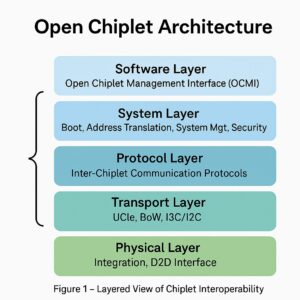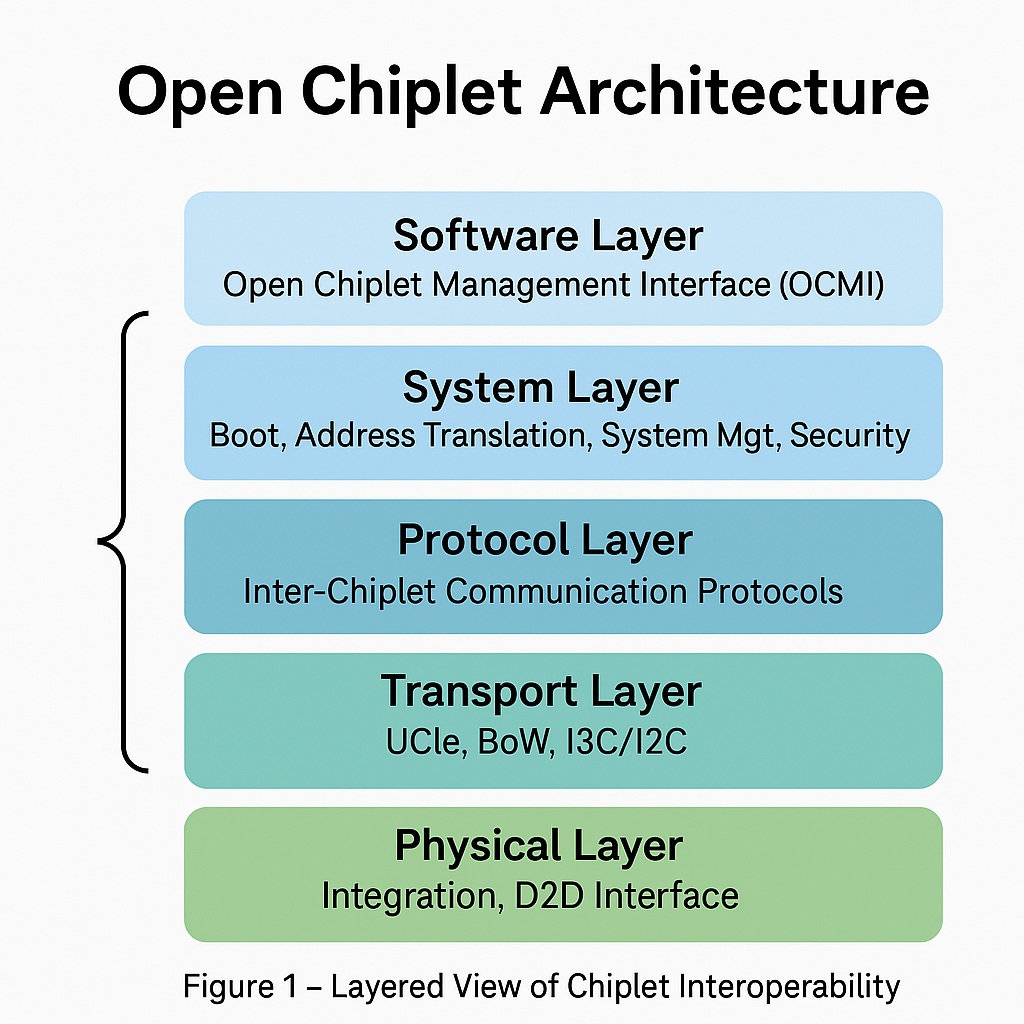
Open Chiplet Architecture (OCA) is an open standard developed by Tenstorrent to address the growing complexity and interoperability challenges of chiplet-based system design. Unlike monolithic SoCs, chiplet-based systems use multiple smaller dies—called chiplets—that are fabricated independently and integrated into a System-in-Package (SiP). OCA standardizes the interfaces and behaviors across these chiplets to enable seamless multi-vendor interoperability.
OCA promotes a “plug-and-play” chiplet ecosystem, enabling both chiplet designers and package integrators to innovate and collaborate using a common framework.
Motivation
While chiplets offer benefits such as modularity, better yield, cost efficiency, and faster time-to-market, they also introduce complex challenges when integrating components from different vendors:
| Domain | Integration Challenge |
|---|---|
| Interconnect | Differing transport/protocol stacks |
| Addressing | Non-unified address mapping |
| Boot | Cross-vendor boot flow coordination |
| System Management | Distributed control loops |
| Security | Incompatible security domains and lifecycle control |
| Interrupts | Inconsistent interrupt delivery |
| FuSa and RAS | Difficult safety/reliability integration |
| Debug/Test | No unified debug/test interface |
| Software | Vendor-specific APIs and protocols |
OCA is designed to solve these challenges by providing a layered and standards-based interoperability framework.
OCA Layered Architecture
OCA defines a 5-layer stack to standardize chiplet interaction:
1. Software Layer
-
Defines the Open Chiplet Management Interface (OCMI) for secure system management and software communication.
-
Supports a signed image format and shared bootloader interface.
-
Enables SiP-wide device configuration via common data structures.
2. System Layer
-
Organizes chiplets into primary and secondary roles.
-
Provides boot flow orchestration, address translation, and hierarchical system management.
-
Introduces SSID/DSID for security domain alignment.
-
Supports IEEE 1838 for post-silicon test, and standard FuSa/RAS interfaces.
-
Implements hardware-based time synchronization.
3. Protocol Layer
-
Supports standard communication protocols (e.g., AXI, CHI).
-
Introduces Open Chiplet Configuration Protocol (OCCP) for boot and management flows.
-
Allows domain-specific protocol extension.
4. Transport Layer
-
Supports high-speed interconnects: UCIe and BoW.
-
Auxiliary transport via I3C/I2C with in-band interrupts for boot, firmware, telemetry, etc.
5. Physical Layer
-
Defines mechanical, electrical, and thermal integration specs.
-
Covers 2D, 2.5D, and 3D integration styles.
-
Standardizes D2D interface design, power delivery, and clock routing.
Profiles
To prevent fragmentation, OCA introduces application-specific profiles:
-
Data Center Profile
-
Automotive Profile
Each profile mandates support for a core set of specifications tailored for that domain.
Design Principles
| Principle | Description |
|---|---|
| Open | Based on open standards—avoids vendor lock-in |
| Standards-Based | Leverages existing, proven industry standards |
| Accessible | Supports wide IP reuse and independent development |
Integration Examples
Figure 1: Inter-vendor SiP Integration
-
Multi-vendor chiplets integrated using all five OCA layers.
-
Standardized across interconnects, boot, and management interfaces.
Figure 2: In-house Chiplet Integration
-
Uses only OCA Software and System layers.
-
Lower layers (protocol/transport) remain proprietary.
Glossary
| Term | Definition |
|---|---|
| AXI / CHI | Bus/protocols for inter-chiplet communication |
| BoW | Bunch of Wires – low-latency die-to-die link |
| UCIe | Universal Chiplet Interconnect Express |
| DSID / SSID | Dynamic/Static Security Identifiers |
| FuSa / RAS | Functional Safety / Reliability, Availability, Serviceability |
| I3C / I2C | Low-speed auxiliary transport |
| OCCP | Open Chiplet Configuration Protocol |
| OCMI | Open Chiplet Management Interface |
Summary
Open Chiplet Architecture (OCA) represents a major step toward achieving true chiplet interoperability. By standardizing layers from software to physical integration, it enables a scalable, modular, and collaborative ecosystem for chiplet-based system design. Developed and championed by Tenstorrent, OCA opens the door for efficient cross-vendor collaboration and accelerated innovation in semiconductors.
Also Read:
Share this post via:












Jensen Huang Drops Donald Trump Truth Bomb on Joe Rogan Podcast